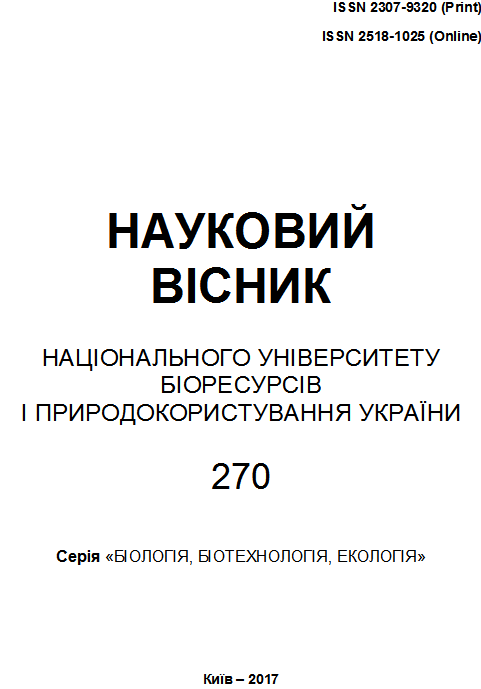EFFECT OF PHOSPHORUS APPLICATION ON THE RATES AND EFFLUX OF CO2 FROM SOIL: 14С LABELING STUDY
Анотація
Global Warming as one of the most important environmental challenge in the XXI century affects crop production, and, thus, is considered as a thread for food security worldwide. Studying the influence of any factors for CO2 efflux is the call of the day. Despite of numerous studies on this topic, the single effect of phosphorus application on CO2 production in soils was poorly understood. Current study aimed to evaluate the influence of increasing P levels with and without C source on CO2 emission rates and total CO2 efflux, and define the source of CO2 by 14C application. P application affects CO2 emission rates significantly at P50 in dormant stage when no C was applied. However, activation of soil microorganisms by C50 led to no P effect within one day after application. Total CO2 efflux 120 h after P50 addition was 1,5 and 2 times greater for no C and C50 treatments respectively, if compared to the mean values for P0 and P10. Nevertheless, experiment with plants should be done to determine the net CO2 emission and take into account the positive effect from P application. The incremental P levels resulted in lower 14CO2 rates for no C treatments, and had the reverse effect at C50 during the first day of experiment. These findings may be further useful for determination the contribution of each component to the global CO2 emission.
Посилання
Alef, K, Nannipieri, P. (1995). Estimation of microbial activities. In Methods in
Applied Soil Microbiology and Biochemistry, Academic Press, 193-270.
Bergkemper, F., Schöler, A., Engel, M., Lang, F., Krüger,J., Schloter M., Schulz, S.
(2016). Phosphorus depletion in forest soils shapes bacterial communities towards
phosphorus recycling systems. Environmental Microbiology, 18(6), 1988–2000.
Bilyera, N. (2017) Effects of P and C inputs on microbial activities in P limiting
bulk and rhizosphere soil Geophysical Research Abstracts Vol. 19, EGU2017-353.
Blagodatsky, S., Smith, P. (2012). Soil physics meets soil biology: Towards
better mechanistic prediction of greenhouse gas emissions from soil. Soil Biology &
Biochemistry, 47, 78-92.
Bleicher, J. Effect of N, organic and mineral acid additions on microbial CO2
emissions in soils of different phosphorus levels. Master Thesis, Georg-AugustUniversity
of Göttingen, 2017. 34.
Bünemann, E.K. (2015). Assessment of gross and net mineralization rates of
soil organic phosphorus: A review. Soil Biology & Biochemistry, 89, 82-98.
Dorodnikov, M., Knorr, K.-H., Kuzyakov, Y., Wilmking, M. (2011). Plantmediated
CH4 transport and contribution of photosynthates to methanogenesis at a
boreal mire: a 14C pulse-labeling study. Biogeosciences, 8, 2365–2375.
Kuzyakov, Y., Blagodatskaya, E.,(2013) Microbial hotspots and hot moments
in soil: Concept & review. Soil Biology & Biochemistry, 83,. 184-199.
Pausch, J., Kuzyakov Y. (2017). Carbon input by roots into the soil:
Quantification of rhizodeposition from root to ecosystem scale. Global Change Biology,
–12.
Senapati, N., Chabbi, A., Giostri, AF., Yeluripati, J. & Smith, P. (2016).
?Modelling nitrous oxide emissions from mown-grass and grain-cropping systems:
Testing and sensitivity analysis of DailyDayCent using high frequency
measurements’. Science of the Total Environment, 572, 955-977.
Smith, P. (2016). ?Soil carbon sequestration and biochar as negative
emission technologies’. Global Change Biology, 22(3), 1315-1324.
WMO greenhouse gas bulletin, 2010. The State of Greenhouse Gases in the
Atmosphere Based on Global Observations through 2009.
Завантаження
Опубліковано
Номер
Розділ
Ліцензія
Стосунки між правовласниками і користувачами регулюються на умовах ліцензії Creative Commons Із Зазначенням Авторства – Некомерційна – Поширення На Тих Самих Умовах 4.0 Міжнародна (CC BY-NC-SA 4.0):https://creativecommons.org/licenses/by-nc-sa/4.0/deed.uk
Автори, які публікуються у цьому журналі, погоджуються з наступними умовами:
- Автори залишають за собою право на авторство своєї роботи та передають журналу право першої публікації цієї роботи на умовах ліцензії Creative Commons Attribution License, котра дозволяє іншим особам вільно розповсюджувати опубліковану роботу з обов'язковим посиланням на авторів оригінальної роботи та першу публікацію роботи у цьому журналі.
- Автори мають право укладати самостійні додаткові угоди щодо неексклюзивного розповсюдження роботи у тому вигляді, в якому вона була опублікована цим журналом (наприклад, розміщувати роботу в електронному сховищі установи або публікувати у складі монографії), за умови збереження посилання на першу публікацію роботи у цьому журналі.
- Політика журналу дозволяє і заохочує розміщення авторами в мережі Інтернет (наприклад, у сховищах установ або на особистих веб-сайтах) рукопису роботи, як до подання цього рукопису до редакції, так і під час його редакційного опрацювання, оскільки це сприяє виникненню продуктивної наукової дискусії та позитивно позначається на оперативності та динаміці цитування опублікованої роботи (див.The Effect of Open Access).

